|
|
Iptables |
|
| Home | Contents | Contact Us |
| Contents » Graphical User Interfaces for Iptables/netfilter | Printer friendly version |
|
Permission is granted to copy, distribute and/or modify this document under the terms of the GNU Free Documentation License, Version 1.1; with the Invariant Sections being "Introduction" and all sub-sections, with the Front-Cover Texts being "Original Author: Oskar Andreasson", and with no Back-Cover Texts. A copy of the license is included in the section entitled "GNU Free Documentation License". All scripts in this tutorial are covered by the GNU General Public License. The scripts are free source; you can redistribute them and/or modify them under the terms of the GNU General Public License as published by the Free Software Foundation, version 2 of the License. These scripts are distributed in the hope that they will be useful, but WITHOUT ANY WARRANTY; without even the implied warranty of MERCHANTABILITY or FITNESS FOR A PARTICULAR PURPOSE. See the GNU General Public License for more details. You should have received a copy of the GNU General Public License within this tutorial, under the section entitled "GNU General Public License"; if not, write to the Free Software Foundation, Inc., 59 Temple Place, Suite 330, Boston, MA 02111-1307 USA |
Chapter 15. Graphical User Interfaces for Iptables/netfilter
One side of iptables and netfilter that we haven't looked at very much yet, is the graphical user interfaces that are available for iptables and netfilter. One of the biggest problems with this is that netfilter is a very complex and flexible setup, that can perform the strangest of tasks. For this reason, it can become a very daunting task to create a GUI for netfilter.
Several persons and organisations have tried to create GUI's for netfilter and iptables, and some have succeeded better than others, while others have given up after some time. All have different reasoning behind their tries as well, so it isn't an easy task to show them all. However, this chapter is a small compilation of some of the GUI's for iptables and netfilter that may be worth looking at. Suggestions on others to add are always welcome.
fwbuilder |
Page Up |
Firewall Builder, or simply fwbuilder, is an extremely versatile and powerful tool that can be used to build your own firewalls, or to maintain several firewalls for that matter. It can be used to create policies for several different types of firewalls, including iptables (Linux 2.4 and 2.6), ipfilter (freebsd, netbsd, etc), openbsd pf, and, a module that must be bought, Cisco PIX.
Fwbuilder has, as you can see, a very big audience and is well taken care of and continues to be developed. It is run on a separate host system, where you create the policy files, and then copy them over and run them on the target system. It is able to handle everything from very simple rulesets to large and rather complicated ones. It has extensive abilities to handle different versions and installations of iptables, by configuration of which targets/matches are available on each host system, etcetera. The end result may be saved in an xml file, or a system parsable configuration file (e.g., the real firewall scripts).
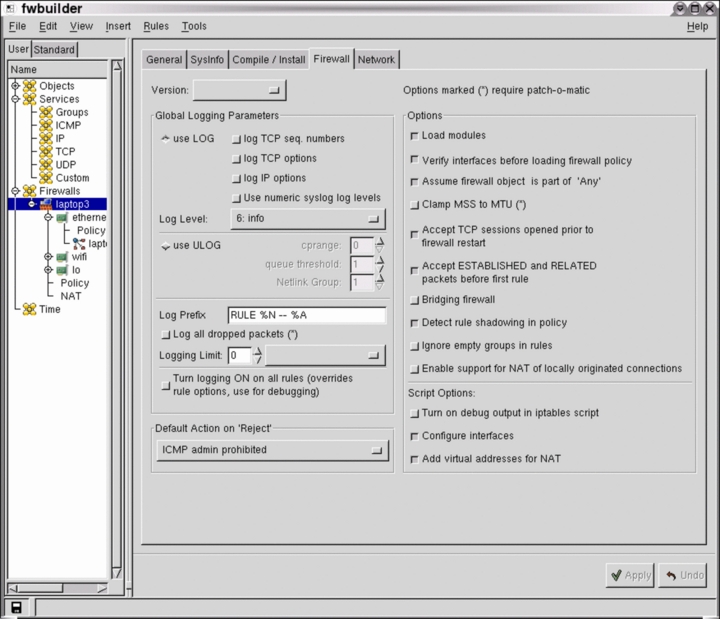
You can see the configuration of the "firewall" in the above example, and the main menus of the whole fwbuilder system. fwbuilder can be found at http://www.fwbuilder.org.
Turtle Firewall Project |
Page Up |
Turtle Firewall is an excellent, yet simpler kind of user interface to iptables. It is integrated in something called webmin (a web administration interface). It is fairly basic, and neither as complex nor able to handle as complex changes as the fwbuilder package, but it is more than able to handle most simpler firewalls, as well as some more advanced ones as well.
One big advantage with Turtle Firewall is the fact that it is web-based, and hence can be remotely controlled in a totally different manner than with fwbuilder and most other tools. Of course, it also adds more of a security risk since webmin is a separate extra service running on the firewall itself.
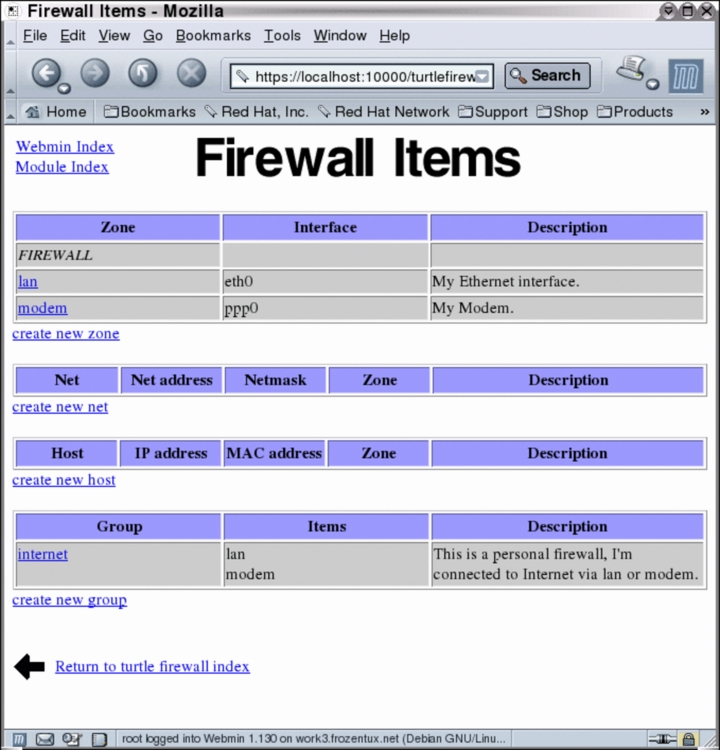
The above screenshot shows the items page of the Turtle Firewall, where you can configure network interfaces and networks, and other items.
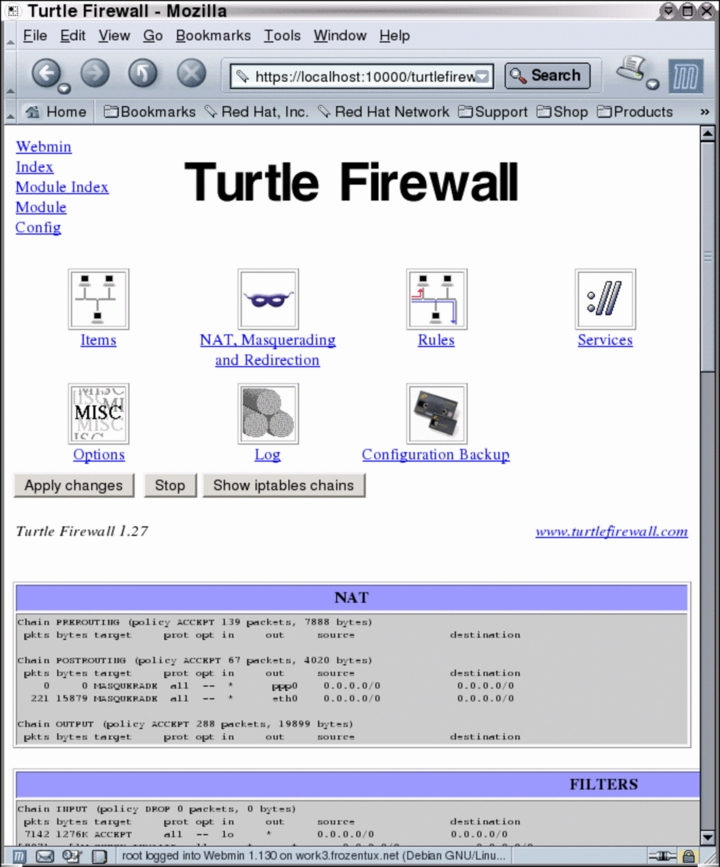
This final screenshot shows the turtlefirewalls main screen, and with the whole ruleset expanded at the bottom. The whole ruleset isn't showing, as you can see, but you get a good general idea of what it looks like in Turtle Firewall.
You can find the Turtle Firewall Project and more information over at http://www.turtlefirewall.com/.
Integrated Secure Communications System |
Page Up |
The Integrated Secure Communications System, or shortly ISCS, is still undergoing development, and no public version has been released. However, this looks like it will become an extremely helpful tool once it is finished. The developer has very high standards, and this is the main reason that it has not been released yet. ISCS integrates several functionalities into a single suite of administration and management user interface. Basically this means that once this project is released, you will be able to fully configure all your firewalls from a centralized point using a single GUI, including VPN's, VLAN's, Tunnels, sysctl's, etcetera.
The main attack angle that the developer(s) of ISCS has, is to simplify management and administration and to remove tedious work for the administrators, so to save as much work hours as possible for the administrators. This is done by putting together policies, and then the programs creates the rulesets and "pushes" them out to the "enforcements points" (e.g., firewalls, proxies, etcetera). The administrator doesn't actually "write" or "click" together the rulesets, just simply put together policies that are then enforced by ISCS.
This tool isn't finished yet, as of writing this. However, I have been in touch with the main developer of this project before, and this is indeed a very large project. When it is finished, I believe this will be one of the best tools on the market. Of course, time can only tell, but it is well worth mentioning here. You can find the ISCS project over at http://iscs.sourceforge.net/.
 |
The main developer, John Sullivan, of ISCS has specifically asked me to ask people to join his development efforts. The project is very big, and he would definitely like as much help with the project as possible. If you are able to help, you are, in other words, more than welcome. |
IPMenu |
Page Up |
IPMenu is a very able program, yet simple to operate and not too demanding on resources nor bandwidth. It is a console based program, so it works perfect over an SSH connection for example. It works perfectly on machines running over a simple and old modem as well.
As you can see from the screenshot, it is able to handle all iptables functionality, including filtering, mangling and nating. It is also able to handle routing tables and bandwidth shaping and to save and restore rulesets. You can add new rules directly into the currently running iptables script easily, and handle all of the different tables. Including adding and removing custom chains.
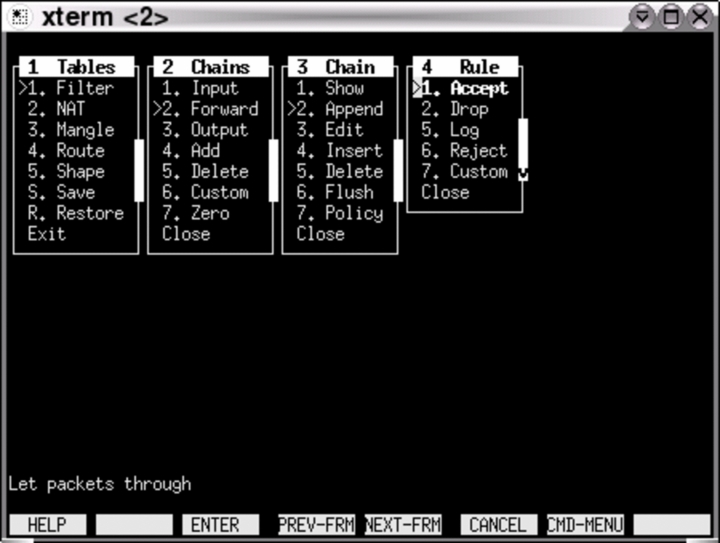
As you can see from the screenshot above, the program is rather basic, but still able to handle most situations rather well. And first of all, it is very simple, and can be used for remote administration simply enough, and since it runs on top of ssh via a standard console, it should also be fairly secure. You can find the homepage of IPMenu at http://users.pandora.be/stes/ipmenu.html.
Easy Firewall Generator |
Page Up |
Easy Firewall Generator is another interesting development when it comes to iptables and netfilter. Basically, Easy Firewall Generator is a PHP webpage where you specify options and specifics of your firewall, and once all of the configurations are done, you click a button, and the webpage spits out an iptables ruleset that you can utilize.
The script contains all the basic rules, and more specific ones to contain strange patterns in packets. It also contains specific IP sysctl changes that may be needed, loads necessary modules, et cetera. The whole ruleset is also written in a redhat init.d format.
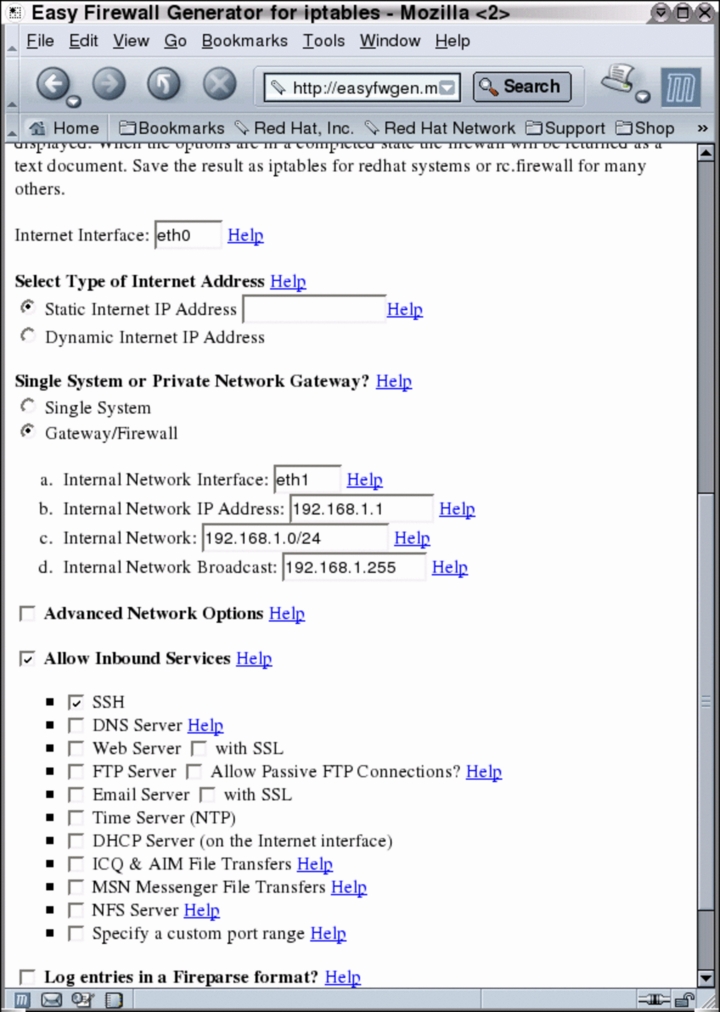
This screenshot shows one of the final stages of configuring the firewall script that is about to be created by the script. You can find more information, and a working version of the Easy Firewall Generator at http://easyfwgen.morizot.net/.
What's next? |
Page Up |
In this chapter we have looked closer at what can be done with some different graphical user interfaces, and other user interfaces as well. Note that there are several more user interfaces around on the market. This chapter has mainly given you an idea of the different types of firewall administration interfaces around on the market. Most of them are open source and free to use, while some will cost a bit of money to get full support or functionality from.
| Hosted by HB.BY | 2008 © iptables.info |